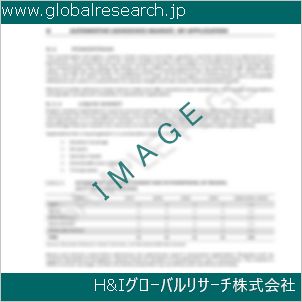Table of Contents
1 Industry Overview of BPDA
1.1 Definition and Specifications of BPDA
1.1.1 Definition of BPDA
1.1.2 Specifications of BPDA
1.2 Classification of BPDA
1.3 Applications of BPDA
1.3.1 Nuclear Application
1.3.2 Non-Nuclear Application
1.4 Industry Chain Structure of BPDA
1.5 Industry Overview and Major Regions Status of BPDA
1.5.1 Industry Overview of BPDA
1.5.2 Global Major Regions Status of BPDA
1.6 Industry Policy Analysis of BPDA
1.7 Industry News Analysis of BPDA
2 Manufacturing Cost Structure Analysis of BPDA
2.1 Raw Material Suppliers and Price Analysis of BPDA
2.2 Equipment Suppliers and Price Analysis of BPDA
2.3 Labor Cost Analysis of BPDA
2.4 Other Costs Analysis of BPDA
2.5 Manufacturing Cost Structure Analysis of BPDA
2.6 Manufacturing Process Analysis of BPDA
3 Technical Data and Manufacturing Plants Analysis of BPDA
3.1 Capacity and Commercial Production Date of Global BPDA Major Manufacturers in 2023
3.2 Manufacturing Plants Distribution of Global BPDA Major Manufacturers in 2023
3.3 R&D Status and Technology Source of Global BPDA Major Manufacturers in 2023
3.4 Raw Materials Sources Analysis of Global BPDA Major Manufacturers in 2023
4 Capacity, Production and Revenue Analysis of BPDA by Regions, Types and Manufacturers
4.1 Global Capacity, Production and Revenue of BPDA by Regions 2019-2024
4.2 Global and Major Regions Capacity, Production, Revenue and Growth Rate of BPDA 2019-2024
4.3 Global Capacity, Production and Revenue of BPDA by Types 2019-2024
4.4 Global Capacity, Production and Revenue of BPDA by Manufacturers 2019-2024
5 Price, Cost, Gross and Gross Margin Analysis of BPDA by Regions, Types and Manufacturers
5.1 Price, Cost, Gross and Gross Margin Analysis of BPDA by Regions 2019-2024
5.2 Price, Cost, Gross and Gross Margin Analysis of BPDA by Types 2019-2024
5.3 Price, Cost, Gross and Gross Margin Analysis of BPDA by Manufacturers 2019-2024
6 Consumption Volume, Consumption Value and Sale Price Analysis of BPDA by Regions, Types and Applications
6.1 Global Consumption Volume and Consumption Value of BPDA by Regions 2019-2024
6.2 Global and Major Regions Consumption Volume, Consumption Value and Growth Rate of BPDA 2019-2024
6.3 Global Consumption Volume and Consumption Value of BPDA by Types 2019-2024
6.4 Global Consumption Volume and Consumption Value of BPDA by Applications 2019-2024
6.5 Sale Price of BPDA by Regions 2019-2024
6.6 Sale Price of BPDA by Types 2019-2024
6.7 Sale Price of BPDA by Applications 2019-2024
6.8 Market Share Analysis of BPDA by Different Sale Price Levels
7 Supply, Import, Export and Consumption Analysis of BPDA
7.1 Supply, Consumption and Gap of BPDA 2019-2024
7.2 Global Capacity, Production, Price, Cost, Revenue, Supply, Import, Export and Consumption of BPDA 2019-2024
7.3 USA Capacity, Production, Price, Cost, Revenue, Supply, Import, Export and Consumption of BPDA 2019-2024
7.4 EU Capacity, Production, Price, Cost, Revenue, Supply, Import, Export and Consumption of BPDA 2019-2024
7.5 China Capacity, Production, Price, Cost, Revenue, Supply, Import, Export and Consumption of BPDA 2019-2024
7.6 Japan Capacity, Production, Price, Cost, Revenue, Supply, Import, Export and Consumption of BPDA 2019-2024
8 Major Manufacturers Analysis of BPDA
8.1 Manufacturer One
8.1.1 Company Profile
8.1.2 Product Picture and Specifications
8.1.2.1 Type I
8.1.2.2 Type II
8.1.2.3 Type III
8.1.3 Capacity, Production, Price, Cost, Gross and Revenue
8.1.4 Contact Information
8.2 Manufacturer Two
8.2.1 Company Profile
8.2.2 Product Picture and Specifications
8.2.2.1 Type I
8.2.2.2 Type II
8.2.2.3 Type III
8.2.3 Capacity, Production, Price, Cost, Gross and Revenue
8.2.4 Contact Information
8.3 Manufacturer Three
8.3.1 Company Profile
8.3.2 Product Picture and Specifications
8.3.2.1 Type I
8.3.2.2 Type II
8.3.2.3 Type III
8.3.3 Capacity, Production, Price, Cost, Gross and Revenue
8.3.4 Contact Information
8.4 Manufacturer Four
8.4.1 Company Profile
8.4.2 Product Picture and Specifications
8.4.2.1 Type I
8.4.2.2 Type II
8.4.2.3 Type III
8.4.3 Capacity, Production, Price, Cost, Gross and Revenue
8.4.4 Contact Information
8.5 Manufacturer Five
8.5.1 Company Profile
8.5.2 Product Picture and Specifications
8.5.2.1 Type I
8.5.2.2 Type II
8.5.2.3 Type III
8.5.3 Capacity, Production, Price, Cost, Gross and Revenue
8.5.4 Contact Information
…
9 Marketing Trader or Distributor Analysis of BPDA
9.1 Marketing Channels Status of BPDA
9.2 Traders or Distributors with Contact Information of BPDA by Regions
9.3 Ex-work Price, Channel Price and End Buyer Price Analysis of BPDA
9.4 Regional Import, Export and Trade Analysis of BPDA
10 Industry Chain Analysis of BPDA
10.1 Upstream Major Raw Materials Suppliers Analysis of BPDA
10.1.1 Major Raw Materials Suppliers with Contact Information Analysis of BPDA
10.1.2 Major Raw Materials Suppliers with Supply Volume Analysis of BPDA by Regions
10.2 Upstream Major Equipment Suppliers Analysis of BPDA
10.2.1 Major Equipment Suppliers with Contact Information Analysis of BPDA
10.2.2 Major Equipment Suppliers with Product Pictures Analysis of BPDA by Regions
10.3 Downstream Major Consumers Analysis of BPDA
10.3.1 Major Consumers with Contact Information Analysis of BPDA
10.3.2 Major Consumers with Consumption Volume Analysis of BPDA by Regions
10.4 Supply Chain Relationship Analysis of BPDA
11 Development Trend of Analysis of BPDA
11.1 Capacity, Production and Revenue Forecast of BPDA by Regions and Types
11.1.1 Global Capacity, Production and Revenue of BPDA by Regions 2024-2029
11.1.2 Global and Major Regions Capacity, Production, Revenue and Growth Rate of BPDA 2024-2029
11.1.3 Global Capacity, Production and Revenue of BPDA by Types 2024-2029
11.2 Consumption Volume and Consumption Value Forecast of BPDA by Regions, Types and Applications
11.2.1 Global Consumption Volume and Consumption Value of BPDA by Regions 2024-2029
11.2.2 Global and Major Regions Consumption Volume, Consumption Value and Growth Rate of BPDA 2024-2029
11.2.3 Global Consumption Volume and Consumption Value of BPDA by Types 2024-2029
11.2.4 Global Consumption Volume and Consumption Value of BPDA by Applications 2024-2029
11.3 Supply, Import, Export and Consumption Forecast of BPDA
11.3.1 Supply, Consumption and Gap of BPDA 2024-2029
11.3.2 Global Capacity, Production, Price, Cost, Revenue, Supply, Import, Export and Consumption of BPDA 2024-2029
11.3.3 USA Capacity, Production, Price, Cost, Revenue, Supply, Import, Export and Consumption of BPDA 2024-2029
11.3.4 EU Capacity, Production, Price, Cost, Revenue, Supply, Import, Export and Consumption of BPDA 2024-2029
11.3.5 China Capacity, Production, Price, Cost, Revenue, Supply, Import, Export and Consumption of BPDA 2024-2029
11.3.6 Japan Capacity, Production, Price, Cost, Revenue, Supply, Import, Export and Consumption of BPDA 2024-2029
12 New Project Investment Feasibility Analysis of BPDA
12.1 New Project SWOT Analysis of BPDA
12.2 New Project Investment Feasibility Analysis of BPDA
13 Conclusion of the Global BPDA (CAS 2420-87-3) Industry 2024 Market Research Report
| ※参考情報 BPDA(ビスフェニルジアミン、CAS番号2420-87-3)は、化学の分野で重要な役割を果たす有機化合物の一種です。この化学物質は、特に高分子材料や樹脂の合成において広く利用されています。BPDAの概念を深く理解するためには、定義、特徴、種類、用途、関連技術について詳しく説明することが重要です。 BPDAの定義としては、ビスフェニルジアミンは、二つのフェニル基(ベンゼン環)がアミン基で結合している構造を持つ化合物です。BPDAは、化学的に安定しており、高い耐熱性を持つことから、高性能材料の製造に必要とされる重要な前駆体とされています。 BPDAの特徴には、まずその高い耐熱性と化学的安定性が挙げられます。これにより、BPDAを含むポリマーや樹脂は、高温環境下でも性能を維持することができます。また、BPDAは優れた機械的特性を持ち、剛性や強度を高めることができるため、様々な工業用途に適しています。さらに、BPDAの分子構造により、反応性も高く、新しい化合物への変換が容易である点もその特徴の一つです。 BPDAにはいくつかの種類があります。具体的には、BPDA自体の変種として、誘導体やそれに関連した化合物が存在します。これらは、異なる用途や特性を持つため、特定の産業ニーズに応じて選択されることがあります。また、BPDAを含む高分子材料として、ビスフェニルジアミン系のポリイミドやエポキシ樹脂などが広く使用されています。 BPDAの用途は非常に多岐にわたります。もっとも一般的な用途は、電子機器や航空宇宙産業における高性能樹脂の製造です。たとえば、BPDAを含むポリイミドは、優れた耐熱性と電気絶縁性を持つため、プリント基板やセラミック基板の材料として利用されます。また、自動車業界でも、軽量かつ高強度の材料として自動車部品に使用されることがあります。 さらに、BPDAはコーティング剤や接着剤、さらには複合材料の製造においても重要な役割を果たしています。これらの用途では、BPDAの特徴を活かして、高温下でも十分な強度と耐久性を持つ製品を生み出すことが求められています。また、BPDAを使用することで、環境への負荷を軽減できる可能性もあります。例えば、より効率的かつエコフレンドリーなプロセスによって高性能材料を製造することができるため、持続可能な技術としての注目も集めています。 関連技術としては、BPDAを用いたポリマー合成技術や、ナノコンポジット材料の開発技術が考えられます。これらの技術は、BPDAの化学的性質を最大限に活かすために進化しており、新素材の開発に寄与しています。たとえば、コンポジット材料としてのBPDA系樹脂は、ナノ粒子と組み合わせることで、さらなる機能性の向上が図られています。これにより、従来の材料では実現できなかった特性を持った新しい製品の開発が進んでいます。 また、最近ではBPDAに関連する環境技術やリサイクル技術が研究されており、持続可能な社会に向けた取り組みの一環としても注目されています。BPDAを含む材料のリサイクルプロセスの開発が進むことで、廃棄物の削減や資源の再利用促進が期待されています。 全体として、BPDAはその特性と多様な用途により、現代の材料科学や工業技術において非常に重要な化合物であることが明らかです。特に高性能材料の開発において、BPDAを用いることで、より信頼性の高い製品を市場に提供できるようになります。また、環境に配慮した製品の開発や持続可能な技術の導入が進む中で、BPDAの重要性はますます高まっていると言えるでしょう。今後もBPDAに関する研究や技術革新が進み、さらなる応用が期待されます。 |
❖ 免責事項 ❖
http://www.globalresearch.jp/disclaimer












